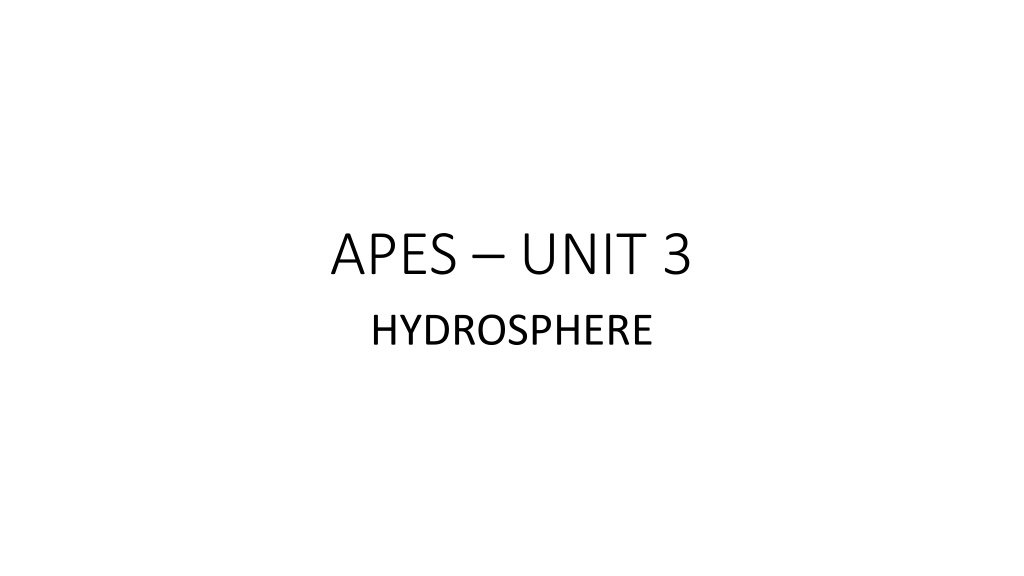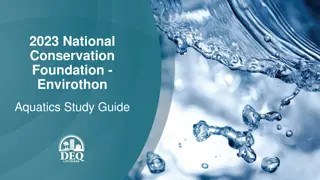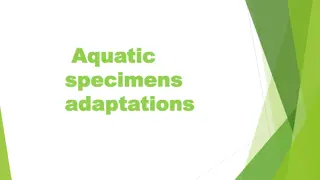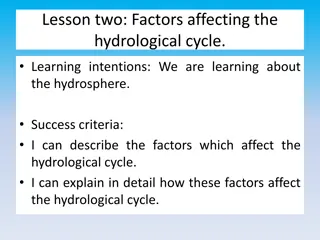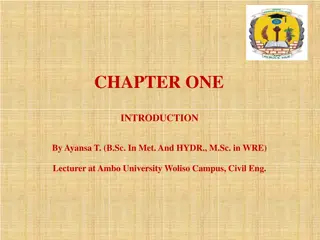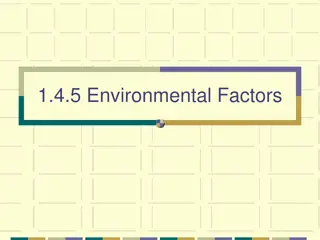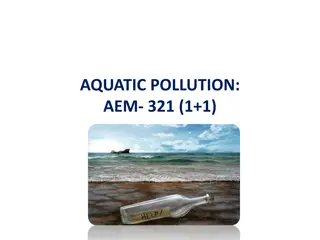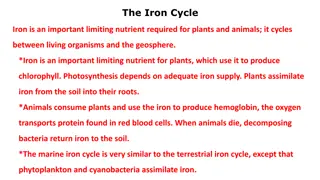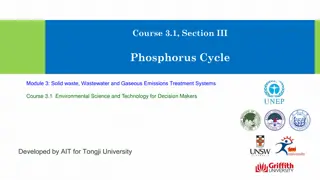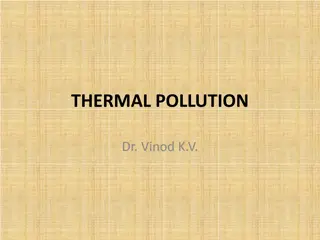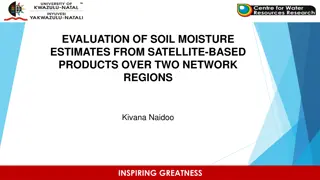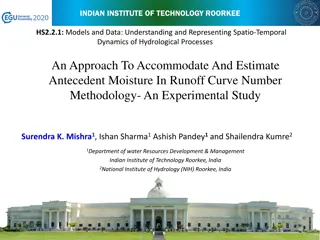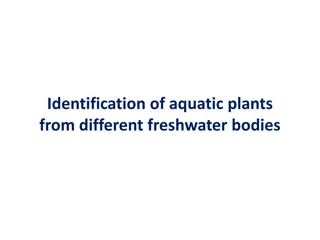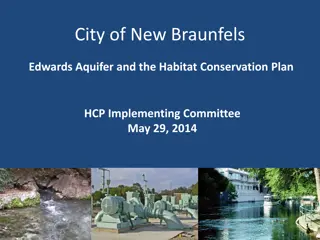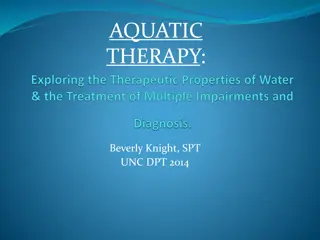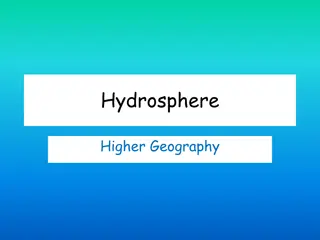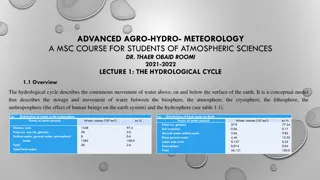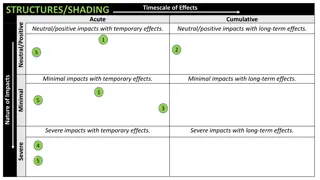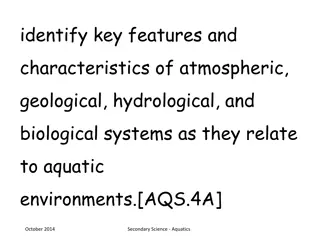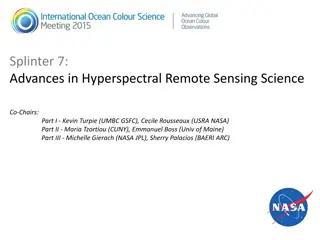Exploring the Hydrological Cycle and Aquatic Environments
Dive into the fascinating world of the hydrosphere with a comprehensive look at the hydrological cycle, water properties, hydrology, salinity, aquatic biomes, and ocean facts. Discover how water moves through Earth's spheres, the distribution of freshwater, the significance of oceans, and their role as global temperature regulators.
Download Presentation

Please find below an Image/Link to download the presentation.
The content on the website is provided AS IS for your information and personal use only. It may not be sold, licensed, or shared on other websites without obtaining consent from the author. Download presentation by click this link. If you encounter any issues during the download, it is possible that the publisher has removed the file from their server.
E N D
Presentation Transcript
APES UNIT 3 HYDROSPHERE
HYDROLOGY -the study of the distribution and movement of water on Earth There are five processes by which water moves throughout each of the earth s spheres condensation precipitation infiltration runoff evapo-transpiration
Water Properties 1. Strong hydrogen bonds 2. Temperature changes slowly (high heat capacity) 3. High boiling and evaporation point 4. Universal solvent 5. Filters harmful UV radiation 6. Expands when it freezes
HYDROSPHERE 75% of Earth is covered by water 97% of all water is in the Ocean 3% of all water is freshwater Fresh water distribution: Ice: 1.762% Groundwater: 1.7% Surface Fresh Water: 0.014% Atmosphere and soil: 0.002%
AQUATIC BIOMES TWO BROAD CATEGORIES: 1. MARINE/SALT WATER (Ex. OCEANS, ESTUARIES) 2. FRESHWATER (Ex. RIVERS, LAKES, WETLANDS) PHYSICAL CHARACTERISTICS USED TO CATEGORIZE INCLUDE: SALINITY, DEPTH, WATER FLOW
SALINITY salt (sodium chloride) Salinity levels are written in parts per thousand (ppt) *ocean salinity = 35 ppt (3.5% salt content) (is affected by rainfall, evaporation, runoff, depth) *freshwater is less than .5 ppt *brackish water has between .5 17 ppt NOTE: when salt water cools and freezes, it gets denser with salt and then it sinks. Ocean salinity increases with depth.
OCEANS - FACTS **ALL THE OCEANS ARE CONNECTED** ATLANTIC OCEAN PACIFIC OCEAN ARCTIC OCEAN SOUTHERN OCEAN INDIAN OCEAN *The largest ocean is the Pacific *The deepest part of the Pacific is at the bottom of the Mariana Trench *The saltiest ocean is the North Atlantic (3.7 ppt) *The salt comes from rocks & underwater volcanic eruptions
OCEAN GLOBAL TEMPERUTURE REGULATOR *the function of the oceans is to absorb sunlight energy which regulates temperatures in the Earth s atmosphere (without oceans, the temperatures would be too extreme for life) *ocean temperatures affect climate and wind patterns *currents that circulate warm waters moderate the climate of northern lands EX. British isles are warmed by the Gulf Stream *ocean evaporation accounts for most of the Earth s precipitation
OCEAN ZONATION by light & temperature Pelagic = all open ocean region Neritic = from low tide to edge of continental shelf, shallow depth to 650 ft, well oxygenated, low pressure, lots of light Oceanic = open sea beyond continental shelf Epelagic / Photic = upper layer, depth (to 200 m) exposed to sunlight for photosynthesis, warmest region, highest level of DO (dissolved oxygen) Bathyal /Disphotic = dimly lit zone, not enough for photosynthesis Abyssal zone / Aphotic = deep area, no sunlight, no photosynthesis, extremely cold, very low DO, high pressure, high level of nutrients from decaying organisms Benthic = lowest level, ocean floor
OCEAN TEMPERATURE ZONES Surface zone = top layer , 300 meters deep, warmed by sun Thermocline = 300 m to 700 m, temperature falls rapidly with depth Deep zone = below thermocline to ocean bottom, dark and cold
OCEAN INTERTIDAL ZONE COASTLINE BETWEEN HIGH TIDE & LOW TIDE Organisms here are exposed to sunlight, high temperatures and desiccation during low tide Organisms are adapted to waves Ex. Barnacles, algae, mussels, crabs, sea stars
OCEAN CURRENTS *Surface currents are steam-like movements of water near the surface driven by wind patterns -can be warm or cold (do not mix) *Deep currents are steam-like movements of water that flow very slowly along ocean floor * driven by difference in density due to temperature and salinity (Denser, saltier water sinks and less dense water rises)
OCEAN CIRCULATION https://www.youtube.com/watch?v=UuGrBhK2c7U *The Ocean Conveyor Belt is driven by thermo-haline currents *Gulf Stream carries warm Caribbean water to North Europe (when it gets to Iceland, it cools, becomes denser and saltier, then sinks creating a powerful, southbound current to Antarctica) *Cold bottom waters warm and rise in Pacific & Indian oceans GYRES = high vortex currents caused by Corioliseffect https://www.youtube.com/watch?v=h6i16CrI8ss
OCEANS - UPWELLING *where prevailing winds from Coriolis effect push warmer, nutrient poor surface water away from coastline *this surface water is replaced by cooler, nutrient rich, deeper waters (deeper waters have high levels of nitrates and phosphates that come from decomposition and sinking of surface waters plankton *upwellings provide nutrient supply for photic regions *Densest water will be at 4 C, when ice melts , surface water will sink, bottom water will move to surface overturning oxygen to bottom and nutrients to top
Currents, Waves & Shorelines currents carried on the surface of the water are called waves when waves meet the land shorelines are created the interaction between the sea and the land causes some erosion of the land which creates sediment sediment is carried into the ocean from the waves
Fresh WaterRivers What is a river? A large channel along which water is continually flowing down a slope made of many streams that come together.
Fresh Water Lakes What is a lake? A body of water of considerable size contained on a body of land.
Lakes are divided into threecategories dystrophic dystrophic lakes low food value full of soil particles water is usually brown oligotrophic oligotrophic lakes lake nourishment very clear water MESOTROPHIC LAKES Somewhat Clear water Medium level of nutrients Has beds of submerged plants eutrophic eutrophic lakes well nourished intense birdlife lots of plankton
POND STRATIFICATION Littoral Zone= shallow area of soil and water near shore where algae & plants grow, most photosynthesis occurs here Limnetic zone= open water, floating algae called phytoplankton found here, extends as deep as sunlight can penetrate Profundal Zone= in deeper lakes, below Limnetic, no sunlight , no photosynthesis, bacteria decompose the detritus consuming oxygen Benthic Zone= muddy bottom of lake/pond
Other Surface Waters What is a wetland? An area where the water table is at, near or above the land surface long enough during the year to support adapted plant growth. wetland 5_Wetland1
Other Surface Waters What are the types of wetlands? Swamps, bogs, and marshes Swamp: a wetland dominated by trees Bogs: a wetland dominated by peat moss Marshes: a wetland dominated by grasses tree-reflections-great-dismal-swamp VoloBog
Fresh Water --Groundwater The water found in cracks and pores in sand, gravel and rocks below the earth s surface. zone of aeration= layer closest to the soils surface Zone of saturation= under surface layer (all open spaces fill with water)
Additional Vocabulary Artesian Well a well in which water rises because of pressure within aquifer. Reservoir a lake that stores water for human use. Tributary-a stream feeding a larger stream or a lake ch10-artesian-well-montreal1
The Water Table saturated zone: the subsurface zone in which all rock openings are filled with water water table: the upper surface of the zone of saturation perched water table: the top of a body of ground water separated from the main water table beneath it by a zone that is not saturated
The Movement of Ground Water most ground water moves relatively slowly through rock underground because it moves in response to differences in water pressure and elevation, water within the upper part of the saturated zone tends to move downward following the slope of the water table Movement of ground water beneath a sloping water table in uniformly permeable rock. Near the surface the ground water tends to flow parallel to the sloping water table
Picture of a hole dug at the beach, showing standing water at the bottom of the hole. Very similar to the top of the water table. Aquifer aquifer: a body of saturated rock or sediment through which water can move easily good aquifers include sandstone, conglomerate, well-joined limestone, bodies of sand and gravel, and some fragmental or fractured volcanic rocks such as columnar basalt
Aquifers (cont.) unconfined aquifer: a partially filed aquifer exposed to the land surface and marked by a rising and falling water table confined aquifer (artesian aquifer): an aquifer completely filled with pressurized water and separated from the land surface by a relatively impermeable confining bed, such as shale
Fresh Water Streams What is a stream? A small channel along which water is continually flowing down a slope made of small gullies.
Springs and Streams spring: a place where water flows naturally from rock onto the land surface some springs discharge where the water table intersects the land surface, but they also occur where water flows out from caverns or along fractures, faults, or rock contacts that come to the surface Water enters caves along joints in limestone and exits as springs at the mouths of caves Springs can form along faults when permeable rock has been moved against less permeable rock. Arrows show relative motion along fault Water moves along fractures in crystalline rock and forms springs where the fractures intersect the land surface Springs form at the contact between a permeable rock such as sandstone and an underlying less permeable rock such as shale
